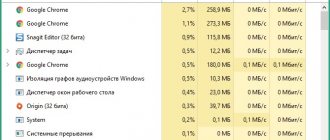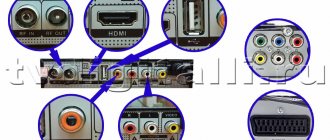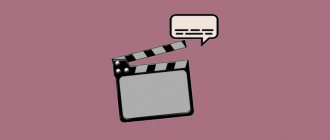Modern smartphones are quite versatile devices, so many people use them even before bed - to surf websites, chat on social networks, read a book... Large and bright screens provide excellent image quality and are convenient. But they have one drawback - the eyes get tired quickly and then you have trouble sleeping.
What's the matter and how to deal with it? The developers of the latest iPhone and Samsung models have tried to solve this problem using the so-called blue light filter. Essentially, this is a special night mode for the screen. Is it useful and is it worth using? Let's look at this issue in more detail.
Why do you need a blue filter?
Any screen emits light in a wide spectrum - from red to violet. Red light has a longer wavelength than blue light. This not only directly determines the color, but also affects our nervous system. After all, electromagnetic waves of different lengths, which include light, have different properties.
The blue light filter on Samsung phones and some others is a screen mode that reduces the amount of blue light. Thanks to this, the image is easier to perceive and looks more pleasant. The solution is simple, but it follows from the following properties of this color:
- The shorter wavelengths of blue light are refracted differently in the lens and vitreous humor of the eye than red light. They are more scattered, and as a result, the blue component of the image on the retina is not so clear, noise is introduced. Therefore, excluding it allows you to make the image clearer.
- Waves in the blue part of the spectrum have a more aggressive effect on the retinal receptors due to their greater energy. Because of this, metabolic reactions occur more intensely in the eyes, and the eye tissue does not have time to utilize their products. This is one of the important reasons why visual acuity decreases and the eyes begin to hurt.
- Blue light suppresses the production of the hormone melatonin, making it difficult to fall asleep. Insomnia may develop. That is why, a few hours before bedtime, it is recommended to put down your gadgets and not use them. Then you will be able to get a full night's sleep and not feel like a broken cart the next day.
The blue filter on your phone limits this color and allows you to avoid these troubles, or at least noticeably reduce them. This is why this technology is needed, which in such a simple way allows you to preserve your vision and well-being.
This innovation is especially useful for the large displays of modern smartphones. They have a high resolution, which means they fit more information on the screen, but it has a lot of small details, and you have to strain your eyes more.
In addition, these screens are quite bright, at least due to their larger surface area, which is good only on a clear day, but excessive in poor lighting. But the more light the screen emits, the more blue it produces. So, the first AMOLED screens were too bright, but now this problem has been solved, and they do not irritate the eyes.
Blue light filter on Android smartphones. Debunking a Popular Myth
Rating of this article according to readers:
5
(46)
We're going to have a tough conversation today, especially if you believe blue light is bad for your eyes. We'll talk about what a blue light filter is (aka reading mode) and whether smartphones need any kind of function to protect their eyesight.
The difficulty of this topic is that we will again talk about electromagnetic radiation. Yes, yes, the same controversial phenomenon that is found in mobile phones and the sensational 5G towers. After all, color is, in fact, the same microwave, only with a wave frequency hundreds of thousands of times higher.
And if there is so much noise around “pathetic” microwaves, then one can only imagine what is happening with visible light, the energy of photons of which already borders on ultraviolet radiation! Fooling around with your eyesight can get expensive, so let's break it down.
As you know, almost all modern smartphones have a function to protect your eyesight at night. Each manufacturer calls it differently:
| Manufacturer | Function name |
| Apple | Night Shift |
| Samsung | Blue light filter |
| OPPO | Night mode |
| Huawei | Eye protection |
| Xiaomi | Reading mode |
| Vivo | Eye protection |
Moreover, there are a huge number of third-party applications that do exactly the same as the tools listed in the table.
But how and from what exactly does this function protect (if at all)? What does blue light do to our eyes and what do blue colors have to do with it if we are just reading a book on a white background?
Red, green and blue... An important theory for understanding the essence of the problem
First, let's deal with the last question (what does blue color have to do with a white screen), and then move on. If you already know the answer to this question, feel free to skip the most interesting part of the article and move on to the next section!
So, white color does not exist in nature. By and large, flowers do not exist at all, as such. There is only electromagnetic radiation.
If some object emits waves 3 meters long, we will not see them, but our radio receiver - no problem! If the wavelength is shorter, say, 12 centimeters, it will be noticed by our smartphone (Wi-Fi signal). But a very short wave, a hundred-thousandth of a millimeter long, will be detected by our eyes and the brain will “see,” for example, the color green (wavelength 550 nanometers).
Thus, electromagnetic waves with a length of 400 to 700 nm are detected by our eyes and interpreted by the brain as different colors:
Color depending on wavelength
This happens due to special photoreceptors (cones) on the retina of the eye. In humans, mainly there are only 3 types of cones, each of which reacts to a wave of a certain length:
Three types of cones
If an electromagnetic wave with a length of 440 nm (violet color) hits the retina, the “green” and “red” cones simply will not feel it and will not send any signal to the brain. But the reaction of the “blue” cones will be maximum.
But what about, for example, the color yellow, since we don’t have “yellow” cones? The fact is that each cone does not respond to a fixed length, but to an entire spectrum with a peak at a certain frequency. For example, a “green” cone will send the maximum signal to the brain if it is “irradiated” with a wave of 540 nm in length. But it will also send a signal when “irradiated” with an electromagnetic wave with a length of 600 nm. Only this signal will be very weak.
Accordingly, when a “yellow” wave hits our eyes, the “red” cones react to it quite strongly and the “green” ones react a little less. Our brain reads the signal level of each cone and then forms a color.
In the following picture you can see the reaction force of each cone to a wave of a certain length. “Blue” cones are designated here by the letter S (from the English short - short waves), “green” - by the letter M (from the English medium - medium waves) and "red" - by the letter L (from the English long - long waves):
But what about a smartphone? How can it emit waves of any length? Actually, not at all. There are not pixels of all possible colors. Instead, we use "pixels", each of which consists of 3 light bulbs (OLED screens): red, green and blue.
In order for a pixel on the screen to display yellow, we simply turn off its blue light, turn on the red light to maximum, and turn on the green light to about 70%. The electromagnetic waves from these light bulbs activate with the same strength (0% blue, 100% red and 70% green) the corresponding cones on the retina of the eye and the brain sums up the received signal, “showing” us the color yellow.
White color is the combination of all waves with a length from 400 to 700 nm, including that same blue light
If a “mixture” of waves of different lengths simultaneously hits the retina, the brain gives us white color. Depending on which waves there will be more in this “composition”, the color temperature : from cold (short waves <500 nm predominate) to warm (more long waves >560 nm). The following animation clearly shows the dependence of color temperature (measured in Kelvin - K) on the number of waves of different lengths in such a “beam”:
For example, daytime white light from the sun includes almost the same number of waves of different lengths from 400 to 700 nm:
Color temperature 5000 K (sun at noon)
And here’s what “warm” (yellowish) white light from an incandescent lamp looks like:
Color temperature 3000 K (200 W incandescent lamp)
As you can see, there are already much fewer short waves (up to 500 nm) and a lot of long ones (>650 nm). However, even in such a “warm” light with a clear yellow tint, there is that same blue light, the dangers of which we will talk about further.
What's wrong with blue light?
While talking about electromagnetic waves, I missed one important detail. Light, like energy, travels in small portions (quanta) and the smallest portion is called a photon. So, the energy of a photon depends only on the wavelength . The shorter the wave, the higher the energy.
It turns out that blue light is the shortest wavelength in the visible range (460-490 nm), which means the energy of such a wave is the highest.
If we go a little further, we will see that the wavelength of ultraviolet radiation is even shorter, and its energy is higher. And here the situation becomes really very dangerous, since after exceeding a certain threshold, the photon energy becomes destructive (ionizing). Such radiation literally destroys molecules, knocking electrons out of atoms.
But let's return to blue light. Its energy is indeed higher than that of any other part of the visible spectrum, and this fact has provoked the emergence of new dangerous diseases, useless products that solve non-existent problems and articles that manipulate readers.
Again, electromagnetic radiation can have a negative effect on cells. After all, the higher the energy of such radiation (the shorter the wave), the more serious the danger it poses. Deadly radiation is exactly the same radiation as light or a radio signal, only with very, very high photon energy (and a very short wavelength).
But if red light with a photon energy of 1.97 eV (electron volts) does not raise any questions, then why are there so many myths around blue light with an energy of 2.75 eV (for comparison, the energy of ultraviolet radiation can exceed 10 eV)?
The main pseudoscientific claim against blue light is that it provokes macular degeneration (destruction of the macula or central part of the retina).
The fact is that today there is not a single scientific proof of this theory. Among the causes of macular degeneration, you will not find a mention of the influence of blue light in any authoritative source [1].
Moreover, the American Academy of Ophthalmology (AAO) has released a series of articles refuting these misconceptions and directly indicating the absence of any harm from blue light [2].
The harm of blue light is about the same phenomenon as the harm of electromagnetic radiation from a phone. All scientific research disproves these theories.
Who is behind the myth about the dangers of blue light?
I would like to say that the yellow press is to blame, but that would not be entirely true. The main “villains” here are businesses or manufacturers of special lenses, glasses (including for computers) or physical filters for screens.
The popular site All About Vision makes absurd claims like this: “The cornea and lens are effective at blocking ultraviolet light from reaching the retina, but when it comes to blocking blue light, our eyes are no longer as good at blocking blue light.” Fine".
The author of the article on the All About Vision website might like to see green skies and seas, but the vast majority of people are not at all opposed to the fact that our eyes do not block blue light (and red and green). Otherwise, how would we see blue colors?
Some manufacturers are more clever about promoting the dangers of blue light by subtly equating it with ultraviolet radiation, and then talking about the dangers of ultraviolet radiation while implying blue light. All this is manipulation. And the facts say this:
- TVs, tablets, computers, smartphones and lamps do not emit electromagnetic waves in the dangerous ultraviolet spectrum [3]
- The sun is the main source of blue light. In 1 hour of walking outside (on a normal day), your eyes will receive the same “dose” of blue light as from 30 hours of looking at a smartphone screen.
But what about studies that have shown that blue light is harmful?
The Legend of the University of Toledo
This is one of the most striking examples of anti-scientific propaganda. If you've ever looked for information about the dangers of blue light, you've most likely come across the news that scientists from the University of Toledo have proven that blue light emitted by smartphone screens is harmful (the study is available on the Nature Research website).
Thousands of websites have reported this information. I’m not even talking about reprints on all sorts of tech blogs, but, for example, even Popular Mechanics published an article entitled “Why does light from screens harm vision?”, which was based on this study.
What's wrong with all this?
First of all, in the study itself there is not even a mention or hint of screens, smartphones and other equipment. That is, no one has tested the effect that blue light from the screen has.
This study was so misinterpreted by the tabloid press that the authors of this paper were forced to issue a statement on their blog, saying the following:
Our paper in Nature Research recently attracted media attention. We caution the public that this study does not show that light from mobile devices or other screens causes blindness...
Source
This study only showed that if retinal molecules, which are also found in the retina of the eye, are irradiated with a blue laser, a substance is released that can destroy cells.
A detailed analysis of this study can be found on the website of the previously mentioned Academy of Ophthalmology. I will give only brief conclusions:
- The cells in the study were not taken from the retina
- The cells in the study were exposed to light in a completely different way than in real life.
- Cells affected by retinal in the experiment do not come into contact with retinal in the human eye
- Retinal is toxic to many cells, regardless of exposure to blue light
- Retinal cells constantly release chemicals to protect against all sorts of toxic effects
This interpretation of the study (blue light destroys the retina) is contrary to common sense. Over thousands of years of human exposure to the open air, the body has perfectly adapted to these conditions. Again, exposure to blue light outdoors for an hour is 30 times greater than blue light exposure from screens over the same period of time.
So are blue light filters necessary on Android smartphones (or Night Shift on iPhone)?
If you are afraid of the harmful effects of blue light on the retina, then the answer from science is clear - no, they are not needed. Not blue filters, not Night Shift, not special apps, not even computer glasses or glasses with a blue light filter.
Blue light does not pose any threat to the retina, and therefore there is absolutely no point in protecting yourself from it.
However…
I admit that I had a rather negative attitude towards my studies at the university in the Faculty of Computer Science, as I believed that the information taught there was hopelessly outdated. After all, technology is developing so quickly, and we are stuck in the 80s, studying Pascal and the Ada language.
But I would never have thought that the same situation applies to the school curriculum, say, in biology.
We learned that our eyes have 2 types of photoreceptors: rods (responsible for black and white vision at night) and cones (color vision in good light). This information seemed as fundamental as 2+2=4.
But in reality, science has long been operating with other concepts and in the eye we have 3 main types of : rods, cones and... I would like to say “diamonds”, but no - internal photosensitive retinal ganglion cells (ipRGC).
So, these third photoreceptors are not responsible for the formation of pictures in our brain, but for the following functions:
- They play a major role in the human circadian rhythm)
- Provides pupil constriction response to light
- Suppresses “flare” from sudden bright lighting (electric welding, sun, spotlight), provoking the release of a special hormone
And the main thing is that the photopigment of these cells, melanopsin, is excited by blue light and the maximum reaction occurs at waves with a length of ~480 nm [4].
It turns out that it is blue light that affects our body. But what harm can such an influence have? It is clear that it is not constriction of the pupil or suppression of a sudden flash. There is only a third option left - managing circadian rhythms.
And, indeed, there are many studies [5] that claim that it is blue light before bed that affects how quickly a person can fall asleep and the quality of sleep in general. Therefore, many doctors recommend limiting smartphone use before bed.
The blue light reduction feature on phones actually works and noticeably reduces the wavelengths in the 450-480 nm range. Here's an example of Night Shift working on iPhone 11 Pro:
(c)DisplayMate
When Night Shift's intensity is at its maximum, blue light levels drop by about 70%, and the Blue Light Filter on the Samsung Galaxy S20 reduces blue light even further:
(c)DisplayMate
But don’t rush to draw conclusions about the benefits of this function. Yes, by turning it to maximum, you will reduce the level of blue light from the screen, and with it a certain negative impact on sleep. But it’s unlikely that this will radically change anything.
First of all, it is not so much the amount of blue light that is important, but the amount of light in general . That is, the brighter the room before bed, the lower the concentration of melatonin will be (and this is the main hormone for regulating the circadian rhythm or biological clock). It is bright light that delays the production of melatonin [7]. If there is any effect of dim light from a smartphone screen at minimum brightness, it is very small.
Moreover, using a smartphone is significantly different from watching the same TV before bed. In the first case, your brain is actively involved in the process (scrolling the feed, reading text, etc.), in the second - only passive observation. Increased brain activity plays just as important a role as the amount of blue light. And the eyes get tired not from blue/red/any color, but from the stress of constantly focusing at close distances, especially with low contrast and image clarity.
Therefore, if you are worried about sleep disturbances, the only way out is to remove any screen 2 hours before bed and fall asleep in a dark room. Everything else (filters, glasses, tin foil hat) won’t really improve the situation.
And then, literally at the end of 2020, a new study was published stating exactly the opposite - blue light from a smartphone can calm the nervous system before bed and help you fall asleep faster, unlike a blue filter [6]. Although, of course, these conclusions require in-depth scientific research.
And finally, here is the most proven and scientific advice on how to avoid any vision problems caused by screens. Just try to look into the distance for at least 10-20 seconds every 20-30 minutes, thereby relaxing the eye muscles. And don’t forget to blink - this is the main cause of eye discomfort from working with gadgets.
Alexey, editor-in-chief of Deep-Review
PS
We have opened a Telegram channel and are now preparing very interesting materials for publication! Subscribe in Telegram to the first popular science site about smartphones and technology so you don’t miss anything!
Did you like the article? Share with others:
- 3
- 1
- 4
Shared
How would you rate this article?
Click on the star to rate it
There are comments at the bottom of the page...
Write your opinion there for all readers to see!
Thank you very much for your feedback!
Pros and cons of the filter
The benefits of this technology were discussed above. It is designed to protect the eyes, preserve vision and well-being, which is why it was introduced. This technology is based on physiological data, which we have already considered, and it is supported at least by the fact that many well-known companies are implementing it.
This filter is used not only on iPhone and Samsung smartphones. It was also implemented by Huawei and Xiaomi. On Huawei smartphones this function is called “Eye Protection”. Among the options, you can set a schedule so that the screen color becomes warmer at certain times of the day.
What could be the harm of a blue light filter? Its use does not cause any harm to either the device or health. This is a purely visual effect when one component is excluded from the entire light spectrum. This makes the light from the screen more pleasant and less annoying.
Another thing is how it is perceived psychologically. Some people simply don't like this feature and prefer regular white light.
Another reason when it is useful to disable it is the use of graphic editors and various work with graphics. In this case, correct color rendering is important, because excluding one of the colors disrupts the image. Even the photograph no longer looks the same as in the original. In such cases, this function will only be harmful.
Lux – eliminates blue light without distorting colors
Although the above filters are effective in eliminating blue light, changing the color tone of the screen can be tedious for some people. It is for such users that the Lux application was created, which does not make changes to the temperature of the screen light, but only affects its brightness .
In this way, we do not completely get rid of the negative effect of blue, but we limit its influence.
Lux offers a range of activity-based profiles that are accessible from the notification panel and a variety of detailed brightness settings. In particular, we can reduce the backlight intensity level, decide on the highlighting of buttons, determine the speed of brightness reduction, etc. A useful feature is the ability to use shaking to increase brightness.
If while using the application we find that reducing the brightness does not bring the expected result, then with the help of an additional setting we can enable the night mode, which, like other applications, activates the blue light filter.
A few additional settings are available in the full version of the application (for example, determining the time of sunrise by location), but, in our opinion, it is quite possible to do without them.
How to turn on the blue filter on your smartphone
The latest versions of the Android system, starting with the Pie version, already have this function. It is turned on in the settings, in the “Display” section - there is an option “Night light”. There you can also set up a schedule for automatically switching to this mode.
On systems of other versions, only some manufacturers have this option - Apple, Samsung, Huawei, Xiaomi, Asus and some others. They introduced this new feature themselves, and it is also enabled in the display settings.
This feature can be used even on smartphones and systems that do not provide it. There are various applications for this - they can be downloaded from the Play Market. For example, the Bluelight Filter application provides even more customization options than the standard function.
In some applications for reading e-books, this mode is “built-in” as one of the additional functions. This allows you to calmly read a book on your smartphone before bed and not worry about insomnia. Such “reader” programs include, for example, the popular Moon+ application.
Share in the comments whether this article was useful to you and how you feel about this feature in general. Do you use it or ignore it, and for what reason?











